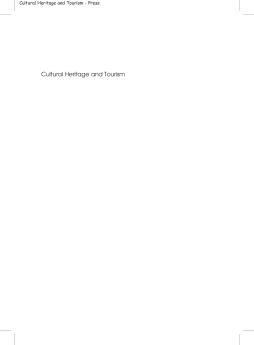
Additional Information
Book Details
Abstract
One of the most salient forms of modern-day tourism is based on the heritage of humankind. The majority of all global travel entails some element of the cultural past, as hundreds of millions of people visit cultural attractions, heritage festivals, and historic places each year. The book delves into this vast form of tourism by providing a comprehensive examination of its issues, current debates, concepts and practices. It looks at the social, physical and economic impacts, which cause destinations, site managers and interpreters to consider not only how to plan and manage resources but also how to portray the past in ways that are acceptable, accurate, accessible and politically relevant. In the process, however, the depth of heritage politics, the authenticity and inauthenticity of place and experience, and the urgent need to protect living and built cultures are exposed. The book explores these and many other current issues surrounding the management of cultural resources for tourism. In order to help students relate concepts to real-world situations it combines theory and practice, is student learning oriented, is written accessibly for all readers and is empirically rich.
This refreshingly new text combines the author's passion for heritage with the latest research in the area to produce a comprehensive and engaging publication. Readers are offered a rich menu of scholarly analysis, comprehensive listing of heritage sites and an extensive catalogue of references. This book can only be described as a must use text for heritage studies.
Prof Bruce Prideaux, School of Business, James Cook University, Australia
This book on cultural heritage and tourism is an important contribution. It sets out the concepts and issues and provides plenty of examples from around the world. In doing so it becomes the key starting point for the study of what it describes as the "most encompassing type of tourism yet to be identified."
Professor David Airey, University of Surrey, UK
Dr Dallen J. Timothy is Professor of Community Resources and Development, Director of the Tourism Development and Management Program, and Senior Sustainability Scientist at Arizona State University. He is also Visiting Professor of Heritage Tourism at the University of Sunderland, England, and Adjunct Professor of Geography at Indiana University. Professor Timothy is Editor of the Journal of Heritage Tourism and serves on the editorial boards of twelve international journals. His primary research interests include cultural heritage; tourism and sustainable development; globalization processes and supranationalism; political boundaries and border issues; biodiversity and tourism impacts; religion, conflict and security; immigration and global diasporas; and peripheral region dynamics.
The extensive experience, knowledge and overriding passion of the author on the subject of cultural heritage and tourism are evident in each and every chapter of this highly valuable text. The ease with which the reader can navigate the material is testament to the expertise and engaging manner of the author with the text providing a highly informative, thought-provoking and contemporary read for students, academics and practitioners in the field. Set within a very logical and coherent structure, the text challenges the reader to engage with the material with the copious supply of examples, case material, review questions, web links and reading lists delivering a valuable resource to those that share the author's zeal for the subject.
Professor Alan Fyall, Bournemouth University, UK
Table of Contents
| Section Title | Page | Action | Price |
|---|---|---|---|
| CONTENTS | 0 | ||
| LIST OF FIGURES | 0 | ||
| LIST OF TABLES | 0 | ||
| LIST OF PLATES | 0 | ||
| PREFACE | 0 | ||
| CHAPTER 1 CULTURAL HERITAGE AND TOURISM | 0 | ||
| SECTION 1 | 0xii | ||
| CHAPTER 2 CONSUMPTION OF CULTURE: HERITAGE DEMAND AND EXPERIENCE | 0xiv | ||
| CHAPTER 3 THE HERITAGE SUPPLY: ATTRACTIONS AND SERVICES | 27 | ||
| CHAPTER 4 SPATIAL PERSPECTIVES AND HERITAGE RESOURCES | 64 | ||
| CHAPTER 5 LOOKING FOR SOMETHING REAL: HERITAGE, TOURISM AND ELUSIVE AUTHENTICITY | 84 | ||
| CHAPTER 6 TOURISM AND THE POLITICS OF HERITAGE | 108 | ||
| CHAPTER 7 THE NEED TO CONSERVE THE PAST: THE IMPACTS OF TOURISM | 130 | ||
| CHAPTER 8 PROTECTIVE LEGISLATION AND CONSERVATION ORGANIZATIONS | 151 | ||
| CHAPTER 9 PROTECTING THE PAST FOR TODAY: HERITAGE CONSERVATION AND TOURISM | 174 | ||
| CHAPTER 10 TELLING THE STORY: INTERPRETING THE PAST FOR VISITORS | 209 | ||
| CHAPTER 11PLANNING PRINCIPLES AND CULTURAL HERITAGEDESTINATIONS | 240 | ||
| CHAPTER 12 MARKETING THE PAST FOR TODAY | 256 | ||
| CHAPTER 13 RAISING REVENUE AND MANAGING VISITORS | 276 | ||
| SECTION 2 | 298 | ||
| CHAPTER 14 MUSEUMS: KEEPERS OF THE PAST | 300 | ||
| CHAPTER 15 ARCHAEOLOGICAL SITES AND ANCIENT MONUMENTS | 317 | ||
| CHAPTER 16 LANDSCAPES OF THE ELITE AND THE ORDINARY | 333 | ||
| CHAPTER 17 THE INDUSTRIAL PAST | 348 | ||
| CHAPTER 18 RELIGIOUS SITES AND PILGRIMAGE | 365 | ||
| CHAPTER 19 DIASPORAS, ROOTS AND PERSONAL HERITAGE TOURISM | 387 | ||
| CHAPTER 20 INDIGENOUS CULTURE | 405 | ||
| CHAPTER 21 DARK TOURISM: ATROCITY AND HUMAN SUFFERING | 424 | ||
| CHAPTER 22 CONCLUSIONS: THE FUTURE OF THE PAST | 454 | ||
| REFERENCES | 468 | ||
| INDEX | 478 |
